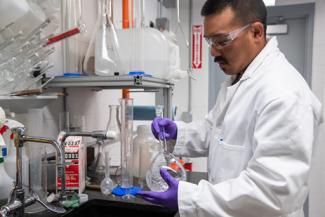When NETL researchers began to research the potential to recover critical minerals from rocks that are processed to remove atmospheric carbon dioxide in a practice called mineral carbonation, they expected to find valuable commodities like chromium, cobalt, and nickel. But their work also discovered valuable quantities of platinum group minerals (PGMs) — extremely precious metal commodities that are critical for the clean energy economy.
The finding could have positive implications for both the critical mineral supply chain and an evolving decarbonization technology.
The discovery was a by-product of research at NETL in Albany, Oregon the home for mineral processing research and development. The federally funded research focused on pulling critical minerals from ultramafic rocks before they are subjected to enhanced mineralization or natural weathering — processes that accelerate the decomposition of calcium and magnesium-rich silicate rocks and a chemical reaction that removes CO2 from the atmosphere. Ultramafic rocks contain minerals that are naturally highly reactive to carbon dioxide. Researchers believe that enhanced mineralization can help stabilize and permanently store CO2.
The samples NETL examined came from the Twin Sisters mine in Washington’s Whatcom County, a source for olivine, an abundant silicate found in earth’s mantle that is used to make molds that can endure high temperatures with low thermal expansion.
Millbank Materials, owners of the Twin Sister’s mine, provided the Lab with access to the raw resources to test NETL mineralization and critical minerals technologies. Eion Carbon, a carbon removal company that focuses on enhanced rock weathering and NETL are working together in a cooperative research and development agreement to advance technology to remove critical minerals while preserving the mineral carbonation potential of the olivine from Twin Sisters Mine.
Circe Verba, Ph.D., of NETL’s Center for Geological and Environmental Systems (GES) said “the breakthrough could help reduce reliance on foreign sources for PGMs by developing a sustainable domestic supply chain in conjunction with mineral carbonation waste streams.”
“This research furthers the goals of the U.S. Department of Energy Fossil Energy and Carbon Management Critical Minerals Sustainability Program,” NETL’s Burt Thomas said. “The team is focused on unconventional ores from waste streams we expect to grow in the future. This will hopefully lower the costs of mineral carbonation and provide secure sources of things like iridium, things that we know we are going to need a lot more of.”
NETL’s GES team tackles the challenges of clean energy production by focusing on the behavior of natural systems at both the earth’s surface and deep within the subsurface. With the laboratory equipment and computational models housed at NETL’s facilities, researchers can peer into the subsurface to discover critical minerals and PGMs that have energy-related value.
Jon Yang, Ph.D., is the lead researcher on the project. He explained that PGMs are critical to manufacturing and automotive sectors as catalytic materials.
“For the green energy transition, platinum and iridium will be crucial for the developing green hydrogen technologies as catalysts for hydrolyzing reactions,” he said. “Coupling the recovery of PGMs with actively mined rocks used in growing enhanced rock weathering industries significantly lowers the technological risks and cutoff grades for traditional PGM extraction.”
According to the U.S. Geological Survey (USGS) Mineral Resources Program, PGM refining has traditionally been a complex process because the chemical similarities of the metals make their separation difficult.
USGS reports that since 1960, approximately 90% of global PGM production came from South Africa and Russia, with Canada, the United States, and Zimbabwe accounting for 5%, 2%, and 1% of production, respectively.
PGMs include iridium, osmium, palladium, platinum, rhodium and ruthenium. PGMs are among the rarest mineral commodities in the earth’s crust and are attracting increased attention for use in a wide range of applications.
- Platinum-based fuel cells are enabling mini-grid electrification technology that is an attractive and cost competitive alternative to grid electrification in remote areas.
- Because platinum is an effective catalyst in hydrogen-powered fuel cells, it is being used in new electric vehicles.
- In the electronics industry, PGE components increase storage capacities in computer hard disk drives and are ubiquitous in electronic devices, multilayer ceramic capacitors, and hybridized integrated circuits.
- The chemical industry uses platinum or platinum-rhodium alloys to manufacture specialty silicones and to make nitric oxide, the raw material for fertilizers, and nitric acid.
- In the petrochemical industry, platinum-supported catalysts are needed to refine crude oil and to produce high-octane gasoline. In addition to making plastics, synthetic rubber and polyester fibers for clothing.
- The glass manufacturing industry uses PGE to produce fiberglass and liquid-crystal and flat-panel displays.
- PGE alloys are exceptionally hard and durable, making them the best coating for the industrial crucibles used to manufacture chemicals and synthetic materials, including the high-purity sapphire crystals used to make light-emitting diodes.
- Because platinum does not corrode inside the human body and allergic reactions to platinum are rare, it is used in medical implants such as pacemakers. PGE are also used in cancer-fighting drugs.
- Because platinum, in certain chemical forms, can slow or stop the division of living cells, platinum-based drugs are being developed to treat cancers.
- Platinum-cured silicones can coat and protect automotive air bags and keep them stable and folded for long durations with deteriorating.
- Platinum-cured silicone mixes are used in lipsticks, shampoos, and contact lenses
NETL is a DOE national laboratory that drives innovation and delivers technological solutions for an environmentally sustainable and prosperous energy future. With its world-class talent and research facilities, NETL is ensuring affordable, abundant and reliable energy that drives a robust economy and national security, while developing technologies to manage carbon across the full life cycle, enabling environmental sustainability for all Americans.




